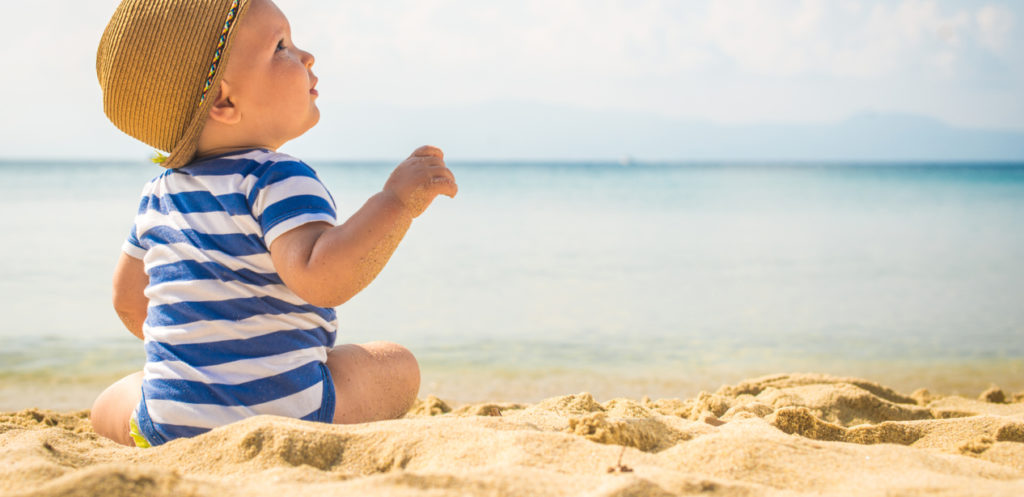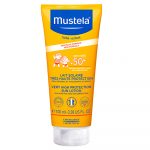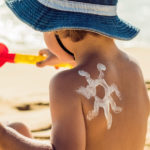Bright sunlight and heat will not only make babies ratty, but it could also seriously damage their skin. A good sunscreen will help protect your child from both UVA and UVB rays, but that’s not the only thing which will keep them safe in the sun. Whether you’re heading abroad this summer or holding out for sunny days at home, find out how to keep babies safe.
Why do I need to keep my baby safe in the sun?
Sun plus kids can mean a sun cream battle – but with skin cancer incidences in the UK increasing nearly 50% over the last decade, it is more important than ever to instill healthy skincare habits in your children from an early age. It’s likely we’ve all experienced sunburn at some point.
In the short term, sunburn is painful, and peeling skin can cause scars or disfiguring. In the long term, exposure to the sun can increase your child’s risk of cancer, and just one incidence of sunburn in childhood can increase their risk of melanoma, which can be fatal.
We’ve all heard the famous “Slip, Slop, Slap” advice – but how do you actually keep children safe in the sun?
Also, read our article Summer Hazards – 14 Things You Need to Know.
How long can my baby be in the sun?
Babies under six months should be kept out of direct sunlight, as their skin does not have enough melanin to protect them from the sun. If your baby is older than six months, they should still be kept out of the sun as much as possible, especially between 11am and 3pm when the sun is at its highest. You’ll need a parasol or sunshade on your pushchair if you go out.
Is sun cream suitable for babies?
Most sun creams are not advised for babies under six months and their skin is particularly sensitive at this age, so you should keep them out of the sun entirely.
If your baby is over six months old, exposure to the sun should be kept to a minimum and you should apply a sensitive, hypoallergenic sunscreen regularly – particularly if they are in and out of the sea or a paddling pool.
UVA and UVB
When choosing a sunscreen, picking the right sun protection factor – which measures the amount of ultraviolet B radiation (UVB) protection – is key. However, UVB is not the only thing that you should be protecting your child from. However high the SPF is on a sunscreen, it does not ensure protection from ultraviolet A radiation (UVA). Both UVA and UVB rays can permanently damage the skin. For full protection from the sun, you need to use sun cream that protects your family’s skin from both UVA and UVB rays.
Can you get burned in the shade?
Yes, you can still get sunburnt out of direct sunlight. You can also burn on cloudy days, and if it’s windy, you may not feel the heat of the sun that would otherwise tell you when it’s time to go indoors.
How can I keep my child safe in the sun?
The NHS recommends that babies and children are protected from the harmful rays of the sun between March and October.
1| Pick good timings
Keep your children out of the sun between 11am and 3pm when it is at its strongest.
2| Always pick the shade
If your child isn’t walking yet, then let them sit and play in the shade – not in direct sunlight.
3| Protect their shoulders and necks
Protect your child’s shoulders and the back of their neck if they’re out playing – these are really common areas to get sunburnt.
4| Pick the right outfits
Cover your child up in loose cotton clothes with long sleeves. Natural fibers will help the skin to breathe.
5| Use sunhats for all ages
Put a sunhat on your baby or child, to shade their face and neck – even if they’ve got a full head of hair.
6| Sunglasses
Your baby should wear sunglasses as early as possible to prevent damage to their eyes. This might be easier said than done – so you might find a wraparound style will help them stay on longer. Sunglasses that carry the CE mark and meet the British Standard (BSEN 1836:2005) should also be worn. UV400 labels will tell you that they offer 100% protection from UV rays.
7| Hydration is important
Make sure your child stays hydrated during hot weather. If you’re breastfeeding, your baby won’t need water as well, but they might want to be fed more often. If you’re bottle feeding, you should give your baby cooled boiled water throughout the day, on top of their regular feeds. Bottle fed babies who wake in the night during hot weather will most likely want milk – but if they’ve had their usual milk feeds, then give them cooled boiled water as well.
If your child is a little older, you should also make sure they drink plenty during hot weather. If they get bored with water and they’re over six months, then you can try diluted fruit juice, ice cubes or homemade fruit ice pops throughout the day.
8| Sunscreen
Apply and reapply sunscreen of factor 15 or above throughout the day. Use one that has UVA and UVB protection.
Also, read our article Protecting Your Child from the Heat Living in the Gulf.
What are the different types of sun cream?
Sunscreens vary widely, not just in terms of their SPF rating but also in application method. You should take into account your baby or child and how easy they are to pin down and rub cream into. Lotions offer a more reliable coverage than sprays, but if you’ve got a wriggler on your hands, a spray might be a better idea.
Spray sunscreens now come in invisible and white options. The invisible is better if your kid is a particularly good runner (away from you, we mean) as they won’t be covered in streaks, but you may prefer the reassurance of the white stuff to see where’s covered. You can also get fun coloured stuff these days that disappears when rubbed in, which might make them more inclined to stay put for half a minute. We say “might”.
What SPF is best?
SPF 15 should be the absolute minimum (as well as a sunscreen offering UVA protection – see above). SPF 30 is optimal, as there is some evidence to suggest that people who wear factor 50 are actually more likely to forget to reapply it, and therefore end up burning.
Contrary to what you might think, SPF 30 is not twice as strong as SPF 15. SPF 15 filters out 93% of UVB rays, whereas SPF 30 protects you from 97% – so there is only a small improvement in the latter.
Do I have to use a sunscreen that is specifically for children?
Children’s skin is more sensitive than adults’, so you should find a mineral based sunblock, one that contains titanium dioxide or zinc oxide. These act as a mirror and are not absorbed into the skin, so are less likely to cause irritation. If your child is fine with the sun cream you use, then there is no harm in continuing to use it. Some parents find that the agents that make kids; sun cream waterproof irritate their children’s skin, so you may find that non-waterproof is better – so long as you remember to keep applying it, of course.








